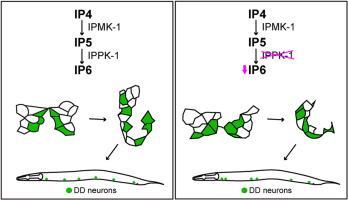IPPK-1和IP6参与秀丽隐杆线虫腹侧神经索组装。
IF 2.1
3区 生物学
Q2 DEVELOPMENTAL BIOLOGY
引用次数: 0
摘要
肌醇磷酸(IPs)对神经系统的发育和功能至关重要。功能丧失的研究表明,特定的IP异构体的重要性,表明他们在适当的神经管形成的关键作用。在这项研究中,我们发现肌醇五磷酸二激酶(IPPK-1),磷酸化IP5生成IP6的激酶,参与了秀丽隐杆线虫腹侧神经索(VNC)的组装。我们发现ippk-1的突变导致新孵化的幼虫沿着VNC的运动神经元错误定位。这些定位缺陷反映了胚胎发生过程中VNC组装的中断,因为ippk-1胚胎中的VNC神经元祖细胞在胚胎的左右两侧出现后,组织更加紧凑,莲座介导的趋同延伸延迟,细胞嵌入缺陷。我们进一步证明,在ippk-1突变体的生殖腺注射外源性IP6可以挽救胚胎和神经元定位缺陷。我们的研究结果表明,IP异构体,特别是IP6,在秀丽隐杆线虫的腹侧神经索形成中是重要的。随着它们在脊椎动物神经管形成中的作用,这些结果表明IP异构体在中枢神经索发育中起着古老的作用。本文章由计算机程序翻译,如有差异,请以英文原文为准。

IPPK-1 and IP6 contribute to ventral nerve cord assembly in C. elegans
Inositol phosphates (IPs) are essential for the development and function of the nervous system. Loss-of-function studies, which demonstrate the importance of specific IP isomers, show their critical role in proper neural tube formation. In this study, we show that inositol pentakisphosphate 2-kinase (IPPK-1), the kinase that phosphorylates IP5 to generate IP6, is involved in assembling the ventral nerve cord (VNC) in C. elegans. We show that mutations in ippk-1 lead to the mispositioning of motor neurons along the VNC of newly hatched larvae. These positioning defects reflect disruption of VNC assembly during embryogenesis, as VNC neuronal progenitors in ippk-1 embryos display a more compact organization after arising on the left and right sides of the embryo, delays in rosette-mediated convergent extension, and defects in cell intercalation. We further show that injection of exogenous IP6 into the gonads of ippk-1 mutants can rescue both embryonic and neuron positioning defects. Our findings indicate that IP isomers, particularly IP6, are important for ventral nerve cord formation in C. elegans. Along with their role in neural tube formation in vertebrates, these results suggests that IP isomers play an ancient role in central nerve cord development.
求助全文
通过发布文献求助,成功后即可免费获取论文全文。
去求助
来源期刊

Developmental biology
生物-发育生物学
CiteScore
5.30
自引率
3.70%
发文量
182
审稿时长
1.5 months
期刊介绍:
Developmental Biology (DB) publishes original research on mechanisms of development, differentiation, and growth in animals and plants at the molecular, cellular, genetic and evolutionary levels. Areas of particular emphasis include transcriptional control mechanisms, embryonic patterning, cell-cell interactions, growth factors and signal transduction, and regulatory hierarchies in developing plants and animals.
 求助内容:
求助内容: 应助结果提醒方式:
应助结果提醒方式:


